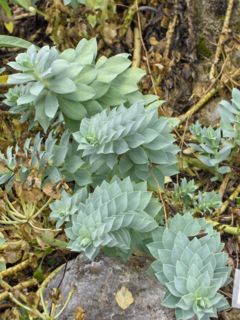Euphorbia myrsinites: Difference between revisions
m 1 revision(s) |
No edit summary |
||
| Line 1: | Line 1: | ||
{{Inc| | |||
Euphorbia myrsinites, Linn. The many declined sts. covered with large, fleshy, glaucous, obovate-oblong, concave, pointed Lvs. in close spirals: umbel 7-12-rayed; glands and fls. yellow: seeds rugose. Eu.—A plant of old gardens; good for walls and rockeries. | |||
}} | |||
{{Taxobox | {{Taxobox | ||
| name = ''Euphorbia myrsinites'' | | name = ''Euphorbia myrsinites'' | ||
Revision as of 11:03, 1 October 2009
| Standard Cyclopedia of Horticulture |
|---|
|
Euphorbia myrsinites, Linn. The many declined sts. covered with large, fleshy, glaucous, obovate-oblong, concave, pointed Lvs. in close spirals: umbel 7-12-rayed; glands and fls. yellow: seeds rugose. Eu.—A plant of old gardens; good for walls and rockeries.
|
| Euphorbia myrsinites {{{status}}} Fossil range: {{{fossil_range}}}
| ||||||||||||||||||||||||||||||||||||||||||||||||||||||||||||||||||
|---|---|---|---|---|---|---|---|---|---|---|---|---|---|---|---|---|---|---|---|---|---|---|---|---|---|---|---|---|---|---|---|---|---|---|---|---|---|---|---|---|---|---|---|---|---|---|---|---|---|---|---|---|---|---|---|---|---|---|---|---|---|---|---|---|---|---|
 | ||||||||||||||||||||||||||||||||||||||||||||||||||||||||||||||||||
| Plant Info | ||||||||||||||||||||||||||||||||||||||||||||||||||||||||||||||||||
| ||||||||||||||||||||||||||||||||||||||||||||||||||||||||||||||||||
| Scientific classification | ||||||||||||||||||||||||||||||||||||||||||||||||||||||||||||||||||
| ||||||||||||||||||||||||||||||||||||||||||||||||||||||||||||||||||
| [[{{{diversity_link}}}|Diversity]] | ||||||||||||||||||||||||||||||||||||||||||||||||||||||||||||||||||
| {{{diversity}}} | ||||||||||||||||||||||||||||||||||||||||||||||||||||||||||||||||||
| Binomial name | ||||||||||||||||||||||||||||||||||||||||||||||||||||||||||||||||||
| Euphorbia myrsinites L. | ||||||||||||||||||||||||||||||||||||||||||||||||||||||||||||||||||
| Trinomial name | ||||||||||||||||||||||||||||||||||||||||||||||||||||||||||||||||||
| {{{trinomial}}} | ||||||||||||||||||||||||||||||||||||||||||||||||||||||||||||||||||
| Type Species | ||||||||||||||||||||||||||||||||||||||||||||||||||||||||||||||||||
| {{{type_species}}} | ||||||||||||||||||||||||||||||||||||||||||||||||||||||||||||||||||
| {{{subdivision_ranks}}} | ||||||||||||||||||||||||||||||||||||||||||||||||||||||||||||||||||
| [[Image:{{{range_map}}}|{{{range_map_width}}}|]] | ||||||||||||||||||||||||||||||||||||||||||||||||||||||||||||||||||
| Synonyms | ||||||||||||||||||||||||||||||||||||||||||||||||||||||||||||||||||
| {{{synonyms}}} |
Euphorbia myrsinites (Myrtle Spurge, also known as Creeping Spurge or "donkey tail"), is a succulent species of spurge (family Euphorbiaceae), native to southeastern Europe and Asia Minor from Italy east through the Balkans to the Crimea and Turkey.[1][2]
It is a herbaceous perennial plant with sprawling stems growing to 20-40 cm long. The leaves are spirally arranged, fleshy, pale glaucous bluish-green, 1-2 cm long. The flowers are inconspicuous, but surrounded by bright sulphur-yellow bracts (tinged red in the cultivar 'Washfield'); they are produced during the spring.[3]
Although sometimes grown as a decorative plant in gardens, particularly valued in xeriscaping in dry areas, myrtle spurge is often considered noxious, and is invasive in some regions. Its cultivation is illegal in the U.S. state of Colorado.[4] The milky sap can cause significant skin and eye irritations.
References
- ↑ Flora Europaea: Euphorbia myrsinites
- ↑ Germplasm Resources Information Network: Euphorbia myrsinites
- ↑ Huxley, A., ed. (1992). New RHS Dictionary of Gardening. ISBN 0-333-47494-5
- ↑ Myrtle Spurge